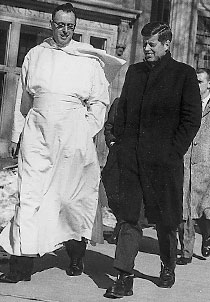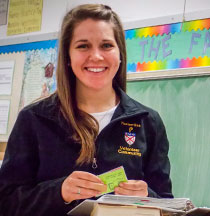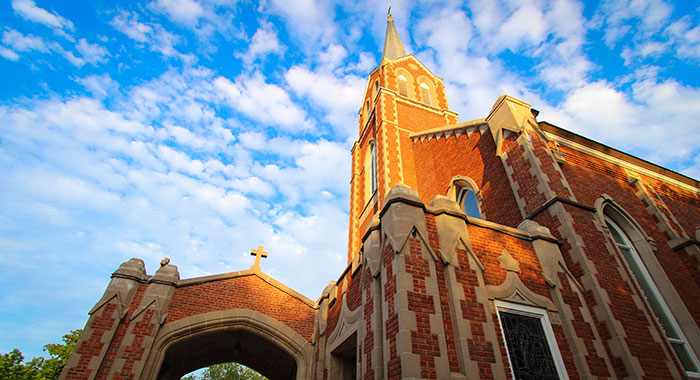Being Norbertine
We live where 900 years of tradition meet the youthful energy of each incoming class. We share a heritage infused with zeal, commitment, devout service and a loving spirit. We were begun, run, governed and educated by men in white robes who knew the value of intentionally creating a common life – and who had the tools to do it. It is their successors who work alongside us today.
All this that combines to make St. Norbert College – its campus, the four-year student experience, the extended family scattered around the globe, the extraordinary reach of the ideas that emanate from the place – unique in all the world. When mission and heritage take such living form on a campus, it’s not hard to say, we’re Norbertine, and we’re proud of it!
Norbertines all around us
We live among a community of saints. While the many white robes on campus fondly recalled by grads of past decades are fewer now – and our Norbertine colleagues are just as likely to be seen in crewnecks as collars – we are surrounded by images of the many Norbertines who have served the college.

St. Norbert strides across our campus, realized in the Granlund statue on the Bemis International Center quad but also in the earliest image of the saint known to us, reproduced as a fresco outside the president’s office.
On the main staircase in Main Hall hang portraits of our early presidents and deans – all of them Norbertine priests. In the alumni house can be seen the Carolyn Barnard portrait of the Rev. Dennis Burke, O.Praem., ’26 crossing campus with a young Sen. John F. Kennedy. (A great-nephew of Burke’s, Silas Gilliam ’16, currently shows prospective students round the college as an admissions tour guide.)
And the foyer of the Mulva Library is now dedicated as a kind of shrine to other men, with portraits of those most significant to the college’s history lining the main staircase. At the foot of the stairs sits the landmark statue of Abbot Pennings, moved inside with the opening of the Mulva Library a few years ago to a new place of honor, protected from the elements. Next to the marble statue, a 21st-century way to honor the memory of the 167 priests who have served the college: an interactive touchscreen where visitors to the library can discover their history. This digital catalog includes images, mini-bios and important dates.
Fleur de lis
 We just call them fleurs, and they’re everywhere you look. They’re in our architecture and our coats of arms, on our football helmets and our bookcases – there’s even one serving as a punctuation mark at the end of this feature article [print issue]. We acquired the stylized symbol for a lily via a French heritage that reaches all the way back to the very first community of Norbertines established in Prémontré, France, on Christmas Eve, 1120.
We just call them fleurs, and they’re everywhere you look. They’re in our architecture and our coats of arms, on our football helmets and our bookcases – there’s even one serving as a punctuation mark at the end of this feature article [print issue]. We acquired the stylized symbol for a lily via a French heritage that reaches all the way back to the very first community of Norbertines established in Prémontré, France, on Christmas Eve, 1120.
Teaching community
 Katie Riesterer ’13 says the Holy Spirit was at work when she met Norbertine Volunteer Community (NVC) director Ellen Mommaerts ’11 (MTS) at her May Commencement. Riesterer, an education major, wanted to spend a year in service; Mommaerts and Green Bay Area Catholic Education (GRACE) president the Rev. Dane Radecki, O.Praem., ’72 had recently spoken about engaging NVC members in GRACE.
Katie Riesterer ’13 says the Holy Spirit was at work when she met Norbertine Volunteer Community (NVC) director Ellen Mommaerts ’11 (MTS) at her May Commencement. Riesterer, an education major, wanted to spend a year in service; Mommaerts and Green Bay Area Catholic Education (GRACE) president the Rev. Dane Radecki, O.Praem., ’72 had recently spoken about engaging NVC members in GRACE.
Four months later, Riesterer began volunteering as a full-time language arts teacher at St. Thomas More School. She lives with two other NVC members at a Norbertine-owned house on Green Bay’s east side.
Her fifth- through eighth-grade students now have Chromebook tablet computers thanks to a St. Norbert alumni grant she received from Old St. Joe’s. She says she loves the classroom and being paycheck-free.
“That’s never really going to happen again in my life, where you’re doing it for the kids and the mission of bringing Christ into the community.”
Living words you’ve perhaps never heard before
Knowing Latin is instructive, but experience best illumines Norbertine ideals. Here, a primer:
 Localitas refers to a Norbertine community’s generations-long commitment to meeting local needs. First-year students live it as part of Into the Streets, a daylong community immersion event during Week of Welcome.
Localitas refers to a Norbertine community’s generations-long commitment to meeting local needs. First-year students live it as part of Into the Streets, a daylong community immersion event during Week of Welcome.
 Praemonstratensian is another word for Norbertine, a member of the Catholic religious order founded by Norbert of Xanten in Prémontré, France, in 1120. Each student is destined to meet at least one who changes their life.
Praemonstratensian is another word for Norbertine, a member of the Catholic religious order founded by Norbert of Xanten in Prémontré, France, in 1120. Each student is destined to meet at least one who changes their life.
 Actio is a Norbertine charism, or spirit, that calls its members to animate faith with action. The college’s many participants in TRIPS alternative break service programs bring their values to life as they become the hands and feet of Christ.
Actio is a Norbertine charism, or spirit, that calls its members to animate faith with action. The college’s many participants in TRIPS alternative break service programs bring their values to life as they become the hands and feet of Christ.
 Contemplatio means contemplation, another Norbertine charism. Pausing for reflection gives action greater meaning: an idea students, faculty and staff explore each Wednesday as they rest or pray during Sacred Hour.
Contemplatio means contemplation, another Norbertine charism. Pausing for reflection gives action greater meaning: an idea students, faculty and staff explore each Wednesday as they rest or pray during Sacred Hour.
 Docere verbo et exemplo is the college motto. It means to teach by word and example, and it happens inside the classroom and outside it, too, as students learn from professors, staff and their peers – and vice versa.
Docere verbo et exemplo is the college motto. It means to teach by word and example, and it happens inside the classroom and outside it, too, as students learn from professors, staff and their peers – and vice versa.
Did you know?
 The very site where the Rev. Bernard Pennings taught Frank Van Dyke his first lesson in Latin is presided over by a statue of St. Norbert. The statue, in front of Old St. Joe’s, was given by the Cristan family in memory of Tony Cristan ’53, who died in a U.S. Air Force helicopter crash on April 25, 1962. Thirteen officers and friends contributed to the memorial. Total cost of the statue, pedestal and engraving was $946.
The very site where the Rev. Bernard Pennings taught Frank Van Dyke his first lesson in Latin is presided over by a statue of St. Norbert. The statue, in front of Old St. Joe’s, was given by the Cristan family in memory of Tony Cristan ’53, who died in a U.S. Air Force helicopter crash on April 25, 1962. Thirteen officers and friends contributed to the memorial. Total cost of the statue, pedestal and engraving was $946.
 The parents of each incoming student are invited to meet the St. Norbert Abbey community at a reception where they can sample beers from abbeys in Europe. Norbertine brews are in such demand in De Pere that Leffe and Grimbergen beers are available in local supermarkets.
The parents of each incoming student are invited to meet the St. Norbert Abbey community at a reception where they can sample beers from abbeys in Europe. Norbertine brews are in such demand in De Pere that Leffe and Grimbergen beers are available in local supermarkets.
 St. Norbert College has been international since 1898. Founder the Rev. Bernard Pennings, O.Praem., came to the United States from Berne Abbey in Holland – sent to northeast Wisconsin to quell a heresy that arose among Flemish settlers in Door County.
St. Norbert College has been international since 1898. Founder the Rev. Bernard Pennings, O.Praem., came to the United States from Berne Abbey in Holland – sent to northeast Wisconsin to quell a heresy that arose among Flemish settlers in Door County.
Among the largest donations the college has ever received was the gift of the Norbertine fathers to endow student scholarships. The $5 million gift from St. Norbert Abbey, received in 2002, continues to create opportunity and fulfills dreams.
 Our oldest living alum is a Norbertine priest. The Rev. Vincent de Leers, O.Praem., ’39, at the age of 96, calls St. Norbert Abbey home. And the newest Norbertines at the abbey – the six men currently in formation– are all graduates of the college: Fraters Patrick La Pacz ’09, Brad Vanden Branden ’09, Matt Dougherty ’09, Michael Brennan ’99, Jordan Neeck ’11 and Jake Sircy ’09.
Our oldest living alum is a Norbertine priest. The Rev. Vincent de Leers, O.Praem., ’39, at the age of 96, calls St. Norbert Abbey home. And the newest Norbertines at the abbey – the six men currently in formation– are all graduates of the college: Fraters Patrick La Pacz ’09, Brad Vanden Branden ’09, Matt Dougherty ’09, Michael Brennan ’99, Jordan Neeck ’11 and Jake Sircy ’09.
 The first commercial radio station in northeast Wisconsin was built on our campus by student-engineer and inventor Cletus Collom ’34, with assistance from the Rev. Ignatius Van Dyke, O.Praem., seminarian James Wagner and Coach George Carey. Wagner functioned as general manager of the station until 1939. WBAY-TV, WBAY-Radio and WHBY-Radio remained in Norbertine hands until they were sold in the 1970s.
The first commercial radio station in northeast Wisconsin was built on our campus by student-engineer and inventor Cletus Collom ’34, with assistance from the Rev. Ignatius Van Dyke, O.Praem., seminarian James Wagner and Coach George Carey. Wagner functioned as general manager of the station until 1939. WBAY-TV, WBAY-Radio and WHBY-Radio remained in Norbertine hands until they were sold in the 1970s.
The Norbertines are canons regular, which is to say that they are priests who live together in community under a rule of life – in their case, under the Rule of St. Augustine. In contrast to monks (who may or may not be ordained), canons regular are an increasingly rare breed in the United States and, indeed, around the world. The Norbertines as an order are further distinguished by their commitment to prayer in the midst of the people.
Along with its academic-year population of 2,200 undergraduates, the college houses a second temporary population. Over the past two winters, St. Norbert has opened its doors to the overflow of homeless people from a Green Bay emergency shelter.
After the Higher Learning Commission last visited St. Norbert for its periodic accreditation review, members said they had never encountered an institution where the mission was so evidently lived at all levels of the organization. The college’s mission statement celebrates its three-fold purpose as a Catholic, Norbertine and liberal arts institution of higher learning – the only such institution in the world.
Living Norbertine on snc.edu
The one word that defines us is not one that trips off the tongue outside our own, thankfully large, circle of friends. While we relish our unique identity, Norbertine is still a tough distinction to shout from a billboard. It’s a problem we put to a small team of consultants when we redesigned the college website. They were intrigued by the value of our claim as the world’s only institution to be founded by the Norbertine order. Their suggestion: a brand-new storytelling section on our website where we could show, not tell, the value of being Norbertine. And that was the beginning of the Pinterest-y, scrapbook e-zine that now publishes under the banner of Living Norbertine.
With content that changes every month, you’ll find a dozen or so current stories that likely won’t use the word Norbertine at all – but they certainly demonstrate its special spirit. We’ve featured a McNair Scholar with a heart for the imprisoned; a young alum whose vibrant coffee shop is helping revitalize a struggling neighborhood; a celebration of the beautiful campus we cherish; an Egyptian artist who focuses on social and political change; and two alums (now married to one another) whose memories of their anatomy classes at St. Norbert prompted them to endow our new cadaver lab. Eclectic and intriguing? Yes. Norbertine? For sure. We hope you’ll find room for a little more Norbertine in your life at livingnorbertine.
Communio
 The Rev. Andrew Ciferni, O.Praem., ’64 (Center for Norbertine Studies) reflects on the one word that lies at the heart of the Norbertine experience.
The Rev. Andrew Ciferni, O.Praem., ’64 (Center for Norbertine Studies) reflects on the one word that lies at the heart of the Norbertine experience.
On the first day of Humanities 337: “Communio and the Norbertines Through the Centuries,” a new course I taught for the first time this spring, I had the 28 students write a short definition of communio as they understood it entering into the course. I suspect that the range of their responses reflects the meanings associated with this word across the college community.
The most frequent responses are in a group I name Civility-Hospitality:
“Treating your neighbor and those around you like friends or brothers. Always being willing to help them. Being kind and showing them you care.”
To the second grouping I give the title Community-Common Life:
“First, community. Sharing of meals, living quarters, kitchens, dining rooms, toilets, colds and other things. But also sharing of life of more than just the sociological kind.
“A higher sense, holiness. But when I hear it in common usage around here it tends to be more secular.”
Then some responses, all from religious studies or philosophy majors or minors, go deeper. I call these The Real Thing:
“Living out the life of God in our daily lives; living out the call of the Eucharist – to take on the call from God to be Christ for others and see Christ in the face of other participants in the community of the Church, all working to spread the message of the gospel.”
“Community, but not just any community. A family community founded on love. The Trinity is family and everything in creation somehow resembles this love relationship. Communiomeans unity in diversity.”
All of these responses are true in part. But the Real Thing responses, though few, are the ones that exhibit an understanding of communio as a New Testament ideal espoused by St. Augustine, and retrieved in the 1960s by the Second Vatican Council in its renewed vision of the Catholic Church.
The Church believes that in creation we are constantly detecting mutuality, interdependent connections, relationships and self-emptying participation in and for the good of one another’s lives. We name this communio. Where it is absent there is intolerance, violence, oppression, greed and selfish manipulation of the earth and other human beings – in a word, sin. In its deepest meaning communio is another name for God, whom we know, understand and believe to be all relationship of Father, Son and Holy Spirit.
Our mission statement, rewritten in 2008, begins, “St. Norbert College, a Catholic liberal arts college embracing the Norbertine ideal of communio ... . ” As a Norbertine and an alumnus, I rejoice in the ongoing retrieval of the college’s identity as an institution rooted in St. Norbert’s dream at Prémontré, which pursued St. Augustine’s dream at Hippo, which sought to make real in his time the apostolic life, the koinonia-communio, of the Jerusalem community (Acts 4:32) global in vision, dialogic in diversity and, above all, one in heart and mind journeying into God (Rule of St. Augustine I, 2). Communio is not a Norbertine invention but a core element of the Catholic Church’s self-identification that the college community is called to claim and embody more broadly and deeply day by day.
July 9, 2014












